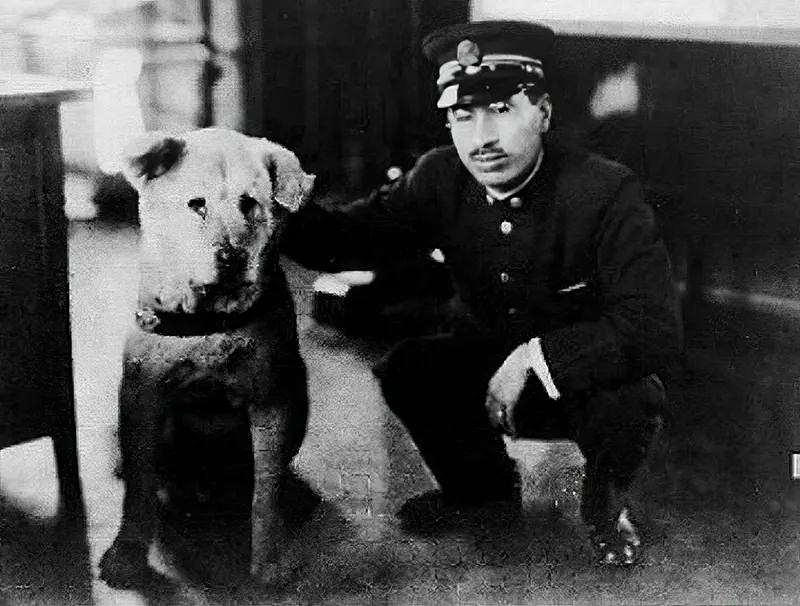Hachiko, an Akita dog, is a symbol of loyalty and devotion in Japan. His story begins in 1923 in a rural part of Japan, where he was born on a farm. As a puppy, Hachiko was taken to Tokyo by Professor Hidesaburo Ueno, who worked at the University of Tokyo. The bond between the professor and his dog would soon become legendary.


The Daily Routine
Every morning, Hachiko would accompany Professor Ueno to the Shibuya train station. The professor would board the train to his university, and Hachiko would return home. In the afternoon, Hachiko would go back to the station to greet the professor when he returned from work. This routine continued for about a year, creating a daily scene that many people in the area came to recognize and love.


A Tragic Turn
On May 21, 1925, tragedy struck. Professor Ueno suffered a fatal brain hemorrhage while at the university. He never returned to the station to meet Hachiko. Despite this, Hachiko continued his daily visits to Shibuya station, waiting for his beloved owner to come back. Day after day, year after year, Hachiko was there, steadfast in his hope and loyalty.



The people of Shibuya noticed Hachiko’s unwavering vigil. Initially, some saw him as a stray and tried to shoo him away. But once they learned his story, they were deeply moved. Station employees and regular commuters began bringing food and treats for Hachiko. They made sure he was well cared for, even as the years passed.
Media Attention
Hachiko’s story began to spread beyond Shibuya. In 1932, a newspaper article about him touched the hearts of many people across Japan. He became a national sensation, and his tale of loyalty was seen as a symbol of the values that were cherished in Japanese culture. The media attention brought many visitors to Shibuya station, all eager to see the faithful dog who waited so patiently.



Hachiko’s Last Days
Hachiko continued to wait at Shibuya station for nearly ten years. His health gradually declined, and he became more frail. On March 8, 1935, Hachiko passed away at the age of 11. He was found near the spot where he had waited so faithfully for his owner.
Hachiko’s death was met with great sorrow. To honor his loyalty, a bronze statue was erected at Shibuya station in 1934, while Hachiko was still alive. The statue quickly became a beloved landmark. During World War II, the original statue was melted down for metal, but in 1948, a new statue was commissioned and placed at the same spot. This statue still stands today and serves as a popular meeting point and a symbol of unwavering loyalty.

Hachiko’s story has had a lasting impact on Japanese culture. It has been taught to schoolchildren as a lesson in loyalty and devotion. Hachiko became a beloved figure in various forms of media, including books, movies, and television shows. His tale transcends generations, reminding people of the deep bond that can exist between humans and their pets.
Hachiko’s story has also gained international recognition. In 2009, a Hollywood movie titled “Hachi: A Dog’s Tale,” starring Richard Gere, brought his story to a global audience. The film adapted Hachiko’s story to an American setting but retained the core themes of loyalty and love. This film introduced Hachiko to many people around the world, further cementing his legacy as a symbol of devotion.
The Hachiko Statue
The statue of Hachiko at Shibuya station remains a significant cultural icon. It is not just a tribute to Hachiko’s loyalty, but also a place where people come to reflect on their own relationships and commitments. Many couples meet at the statue, seeing it as a symbol of love and dedication. Visitors from around the world come to pay their respects and take photos, keeping Hachiko’s story alive.


Apart from the statue at Shibuya station, there are other tributes to Hachiko. In Odate, his birthplace, a museum dedicated to the Akita breed features exhibits about Hachiko. There is also another statue of Hachiko and Professor Ueno together, celebrating their bond. These tributes ensure that Hachiko’s story is remembered and cherished in various forms.

The Akita Breed
Hachiko’s story has also brought attention to the Akita breed. Known for their loyalty and intelligence, Akitas have become more popular as pets, both in Japan and internationally. People admire the breed for its qualities, many of which were exemplified by Hachiko. Organizations dedicated to the breed work to promote responsible ownership and celebrate Akita’s unique characteristics.









Tell me, is there a more detailed description of the life of Hachiko and Professor Ueno? How did they live before the tragedy? What was their relationship like? How much did Ueno love Hachiko?